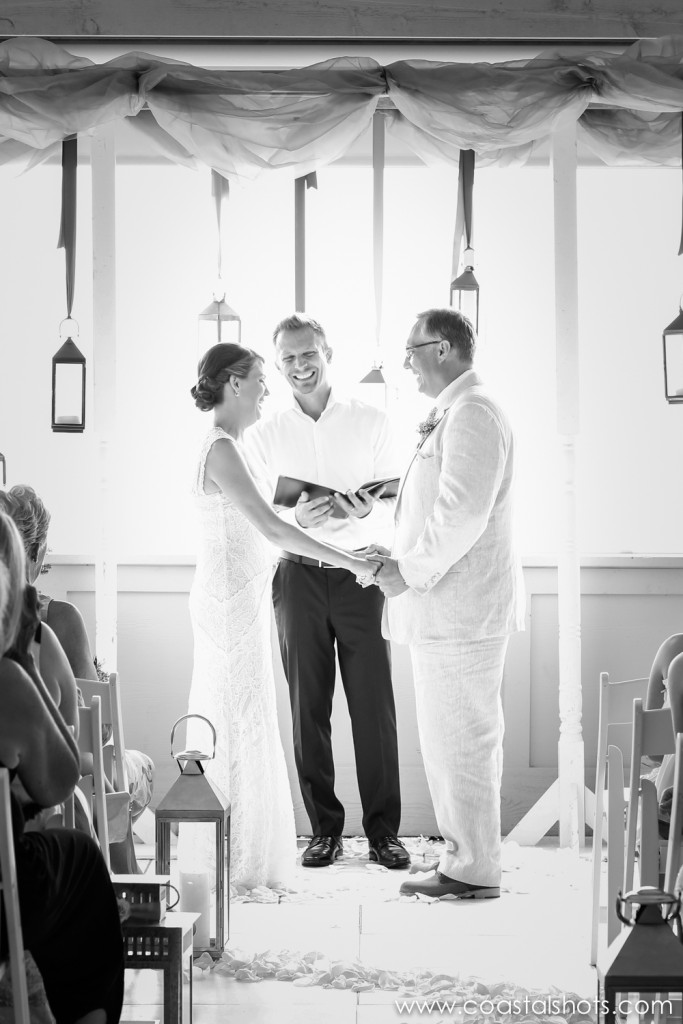Traditional Ceremony Elements and Their Purposes
As you read through the description for each of the traditional ceremony elements in this section, you may choose which elements to include and which ones to leave out of your ceremony.
Procession
(also known as the Wedding March)
This is the choreographed walk down the aisle of the wedding party to the altar. This symbolically represents two things: the couple’s transition from their individual lives to the union of marriage and the wedding attendants’ support of the union by taking part in the same walk. The Officiant, Groom and Best Man wait at the altar for the wedding party to walk down the aisle in the following order: first the Groomsmen paired with the Bridesmaids, followed by the Maid or Matron of Honor, then the Ring Bearer, then the Flower Girl, and lastly the Bride and her Father. Facing the altar, the women will be on the left and the men will be on the right. In addition, traditionally, the guests will be seated on the same side of the altar as the one (bride or groom) who invited them. Music played for the Procession can be a single selection or multiple selections (a selection for the wedding party and a different selection for the Bride, etc.). Order of Procession (Keep in mind that it is your wedding and you may arrange your wedding party in any order you choose.)
Approval Blessing
(also known as the “Give Away”)
This element gives others the opportunity to give their approval or blessing on the ceremony that is about to take place. Traditionally the father or the parents of the Bride answer “I do” or “We do” to a question asked by the Officiant.
Welcome/Introduction
(also known as the Convocation)
This element calls together all in attendance to begin the ceremony. The words spoken at this time welcome and thank the guests as well as introduce the purpose of this gathering.
Opening Blessing
(a prayer also known as the Invocation)
The words spoken at this time are intended to invoke a higher source (God, Goddess, Great Spirit, the Universe, etc.) to elevate the intent of the ceremony. The Address (also known as the Sermon) This element shares with the guests, the couple’s beliefs on the meaning of marriage, and is designed to encourage reflection on the significance of this commitment. This may also include a historical reflection on the couple’s relationship up until this point, as well as the story of how the couple met.
Dedication Blessing
(a prayer also known as the Consecration)
The words spoken at this time are meant to elevate the intent of the message communicated in the Address and remind everyone that the commitment about to be made is sacred. This element also provides a transition from the message about marriage just spoken to the actual promises that the couple is about to make to seal their commitment.
Declaration of Intent
(a legally required element of the ceremony)
This element is the “I Do” section of the ceremony. The words spoken at this time declare the couple’s intention to marry. The declaration is customarily made by the Bride and Groom, each answering “I do” or “I will” in response to a question presented by the Officiant.
The Vows
This element is the verbal exchange between the couple that expresses the sincere promises they are making to each other regarding their intention for the marriage. The words spoken at this time may be memorized, read from paper, or recited after the Officiant.
Ring Blessing
The words spoken at this time describe the purpose of exchanging the rings and the sentiment that the couple wishes to be reminded of as they wear them.
Exchanging of the Rings
This element is the physical exchange of wedding rings and the verbal exchange between the couple that expresses the significance of this offering. The words spoken at this time may be memorized, read from paper, or recited after the Officiant.
Pronouncement of Marriage (a legally required element of the ceremony)
This element is the pronouncement that the couple is officially wed.
The Kiss
This element is a kiss shared between the couple and symbolically represents the sealing of the promises made. The words spoken at this time instruct the couple to kiss.
Closing Blessing
(a prayer also known as the Benediction)
The words spoken at this time are meant to send the couple off into their new future together, and to communicate the hopes and wishes for that future.
The Presentation
This element is the official introduction of the newly married couple.
The Recession
This element is the choreographed walk down the aisle of the wedding party away from the altar and to the festivities. This walk signifies the completion of the ceremony and the beginning of the celebration. Traditionally, the wedding party exits in the opposite order they entered with the Bride and Groom exiting first.
Readings and Additional Ceremony Elements
Readings consist of one or more selections (poems, lyrics, stories, etc.) to be read aloud during carefully selected moments throughout the ceremony. The selections are meant to convey a feeling or message that provides a window into the couple’s unique world and may be read by a friend, family member or the Officiant. Readings may also be incorporated into the ceremony as the wording for one of the traditional ceremony elements.
Additional Ceremony Elements are special purpose mini ceremonies that are performed to further symbolically demonstrate any commitments or statements you wish to communicate. For example, the Sand Ceremony (the blending of sand from either the place they are standing or from prepared glasses) may be included to symbolize the joining together of two lives into one.

